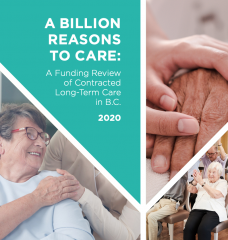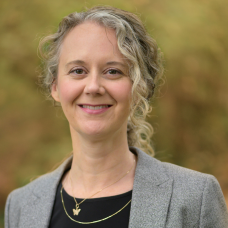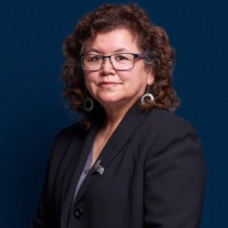Seniors Advocate Report on Funding of Contracted Long-Term Care
April 21, 2020
BY Sara Pon
Introduction
On February 4, 2020 the Office of the Seniors  Advocate (OSA) released the report A Billion Reasons to Care: A Funding Review of Contracted Long-Term Care in B.C. This report examines the funding of contracted long-term care providers, both for-profit and non-profit. The OSA was concerned that the current funding model would create incentives that would compromise care standards and the welfare of long-term care residents. The report advocates for “…those who regulate and oversee publicly funded care homes ensure that care and service standards are met, and contracted care homes spend the public’s money in areas that will have the biggest positive impact on those who live there.”
Advocate (OSA) released the report A Billion Reasons to Care: A Funding Review of Contracted Long-Term Care in B.C. This report examines the funding of contracted long-term care providers, both for-profit and non-profit. The OSA was concerned that the current funding model would create incentives that would compromise care standards and the welfare of long-term care residents. The report advocates for “…those who regulate and oversee publicly funded care homes ensure that care and service standards are met, and contracted care homes spend the public’s money in areas that will have the biggest positive impact on those who live there.”
Currently in BC:
- Who operates long-term care homes are almost evenly split: 38% by health authorities, 34% by for-profit companies, and 28% by non-profit organizations.
- This differs by health authority. For example, Northern Health operates all but one long-term care facility in that jurisdiction. Fraser Health only operates 22% of the long-term care facilities in that jurisdiction.
- Over the past 20 years, the biggest increase in long-term care facilities has been in for-profit companies.
Funding is distributed in a block of money unique to each care home. Funding is calculated in per diems, based on the number of care hours per day and number of publicly-funded beds in the facility. These per diems range from $171 to $282 per resident per day. To examine how long-term care is funded, the OSA examined audited statements and detailed financial reports, as audited statements lacked the necessary details. Northern Health was excluded from the analysis because there were so few contracted facilities that they could be identified in the data. Revenue includes the health authority funding, client contribution, private beds, and other sources of income. Expenditures include care staff, non-care staff, building expenses, supplies, and any profit or surplus.
Direct Care Funding and Monitoring
Staffing costs were the biggest expenditures for contracted long-term care facilities. The OSA report found that direct care accounted for 59% of non-profit facilities’ spending and 49% of for-profit facilities’ spending. Both types of contracted facilities were funded to provide a similar number of direct care hours. However, “…the non-profit sector spent 24% more (almost $10,000) per resident, per year.” The for-profit facilities paid less wages and benefits for each type of care staff. These lower wages mean that for-profit facilities have less experienced staff, more casual employees, more staff turnover, and sometimes not enough employees to provide proper care levels. This leads to reduced continuity of care. The OSA report notes that paying staff wages that match industry standards leads to recruiting more employees, and employees are more likely to stay longer.
The OSA report was not able to determine if the contracted long-term care facilities were providing the number of care hours they were funded to provide. Facilities do not have to report how many hours of care they deliver, and there are vastly different methods used by health authorities to calculate care hours. The funded hours should include wages, benefits, and replacement of employees when they are sick, on vacation, or training. However, these funded hours may not fully translate to care hours delivered if the employees are not replaced when away, or if they are doing non-care activities during their workday (such as cleaning or administrative tasks). Health authorities were not consistent in whether they required funded or worked hours to be reported, and what was counted.
The OSA report found that health authorities sometimes did not count a care facility as being fully occupied, and this could pose a problem for care facilities being able to deliver all the needed care. For example, during the move-in period for a new resident a bed may be empty for a few days but for most of the year all the beds would be full. This means that for the majority of the year the facility is at 100% occupancy, but the care facility may only be funded as if they are 98% full. The facility would not have the funding to provide all the care hours for every resident when all beds are full.
Building Costs
The OSA report found that buildings and land costs accounted for 20% of the spending of for-profit facilities, but only 9% of non-profit facilities. Each health authority took a different approach to what building expenses could be included in the funding. These costs could include the mortgage principle, depreciation, mortgage interest, amortization, and replacement reserves. Some health authorities allowed different building costs to be covered for for-profit facilities but not the non-profit facilities. Building costs varied significantly, and sometimes exceeded fair market value. The OSA review found that for-profit facilities had significantly more building costs but also had higher profits, which was counter-intuitive and concerning.
Reporting
The OSA found long-term care facilities’ financial reporting was not clear or consistent. She identified three concerns:
- There was a lack of consistency in what could be counted as revenue and expenses, especially for private beds (the majority of which were in for-profit facilities). Profits were likely under-reported.
- Most health authorities allowed funds to be spent on head office, management, or administration, but these amounts were reported in a single dollar value. This meant the OSA could not determine how this money had been spent.
- Most of the care facilities were part of a chain of care facilities, and this made it difficult to analyze the spending of the company versus the individual care facility.
Profit/Surplus
The OSA report found that while an equal number of for-profit and non-profit facilities reported a profit or surplus in a year, the vast majority of the profit dollars were generated in for-profit facilities, 34.4 million versus 2.8 million in profit or surplus. The OSA report found that for-profit facilities, both large and mid-sized, reported the highest building costs and large management fees, while also posting the highest profits. The reason for the significantly higher profits in for-profit companies seems to lower wages and benefits paid to staff.
Recommendations
The OSA report concluded that “…financial incentives of our current system may be producing some unintended consequences and our funding and financial reporting is disjointed, unfair to the non-profit sector, and unaccountable to the public.” The OSA’s report makes five recommendations aimed at ensuring the “…$1.3 billion of public money invested in the contracted long-term care sector is spent in a way that is resident-focused, that is fair and equitable, and that represents good value.”
- “Funding for direct care must be spent on direct care”
- The report recommends requiring contracted facilities to use un-spent government funds on providing more direct care or return the funds. This would hopefully lead to better care and increased staff retention.
- “Monitoring for compliance with funded care hours must be more accurate”
- The report suggests requiring beds to be counted at 100% occupancy and changing regulations to allow the health authority to monitor staffing levels (this approach is taken in BC’s childcare regulatory regime).
- “Define profit”
- The regulations or contracts should outline how funds can be spent, especially for building capital, administration and management, and subcontractors. These rules should be consistent across all the health authorities.
- “Standardize reporting for all care homes throughout B.C.”
- “Revenues and expenditures for publicly funded care homes should be available to the public.”
Protecting Older Canadians in Long-Term Care
To date one of hardest hit populations from COVID-19 has been older adults living in long-term care. This has led to great media attention on the low staffing levels, poor compensation for health care workers, and issues monitoring quality of care that occur in long-term care. However, the OSA report demonstrates that these issues are not only occurring because of COVID-19, but that they were ongoing pre-existing issues. What has been highlighted by the crisis is the toll that lack of proper staffing and quality of care monitoring takes on older Canadians. To reduce the spread of COVID-19 in long-term care facilities, the BC government issued a directive that employees can only work at one facility. This directive will increase the staffing challenges in long-term care, although it appears to be a needed step to reduce the spread of the virus. The wages of staff in private facilities has been topped up to match the wages in health authority run long-term care facilities. For more information on this issue, see Daniel Fontaine’s article in the National Post.
To better protect vulnerable people living in long-term care, especially private for-profit facilities, BC needs to make changes to how long-term care funding and staffing are regulated. The topping up of wages in BC is a good step. Ensuring sufficient wages for long-term care staff will help retain qualified health care professionals and increase staffing levels, leading to higher quality care. Increased wages for long-term care staff should continue beyond COVID-19 to help with the systemic problems in recruiting and retaining well-trained staff. Increased monitoring and reporting of finances, staffing levels, and quality of care would help ensure that our most vulnerable citizens are receiving the high-quality care that they deserve, not only during a crisis, but every day.
Further Information
To read the full report, visit the Office of the Senior Advocate’s website.
To learn about the decision-making rights of people living with dementia, see CCEL’s decision-making rights booklet and videos.
Seniors First BC provides legal services for people aged 55 and older in BC. The SAIL line provides resources, referrals, and support for people experiencing abuse or needing legal assistance. Call SAIL toll-free at 1-866-437-1940.
The Advocacy Centre for the Elderly provides legal services for eligible low-income seniors in the Greater Toronto Area. Call ACE at 1-855-598-2656.
If you are a caregiver who needs support Family Caregivers of BC has a Caregiver Support Line, caregiver support groups, and resources.
















































